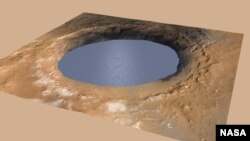Billions of years ago, a lake once filled the 96-mile- (154-km) wide crater being explored by NASA's Mars rover Curiosity, bolstering evidence that the planet most like Earth in the solar system was suitable for microbial life, scientists said on Monday.
The new findings combine more than two years of data collected by the rover since its sky-crane landing inside Gale Crater in August 2012.
Scientists discovered stacks of rocks containing water-deposited sediments inclined toward the crater's center, which now sports a three-mile (five-km) mound called Mount Sharp.
That would mean that Mount Sharp didn't exist during a period of time roughly 3.5 billion years ago when the crater was filled with water, Curiosity researchers told reporters during a conference call.
"Finding the inclined strata was ... a complete surprise," said lead scientist John Grotzinger, with the California Institute of Technology in Pasadena.
"Sedimentary geology ... is the cutting edge for trying to understand the Earth. When oil companies collect seismic surveys across places, they are looking for inclined strata because then you get geometry that tells you where the rocks are that you're looking for," he added.
Shortly after landing, Curiosity found that Mars once had the chemical ingredients and the environmental conditions needed to support microbial life, fulfilling the primary goal of its mission.
The rover then began driving toward Mount Sharp to look for other habitable niches and learn if the life-friendly environments actually existed long enough for life to evolve, a complicated question since scientists don't even know how long it took for life to form and take hold on Earth.
"The size of the lake in Gale Crater and the length of time and series that water was showing up implies that there may have been sufficient time for life to get going and thrive," said NASA's Mars Exploration Program scientist Michael Meyer.
The new studies, which have not yet been published, point to a series of wet and dry times at Gale Crater, challenging a previously held notion that Mars' period of warm climate was early and relatively short-lived, scientists said.
"All that driving we did ... just didn't get us to Mount Sharp. It gave us the context to appreciate Mount Sharp," Grotzinger said of the rover, which has traveled around five miles (eight kms) since landing on Mars in 2012.











